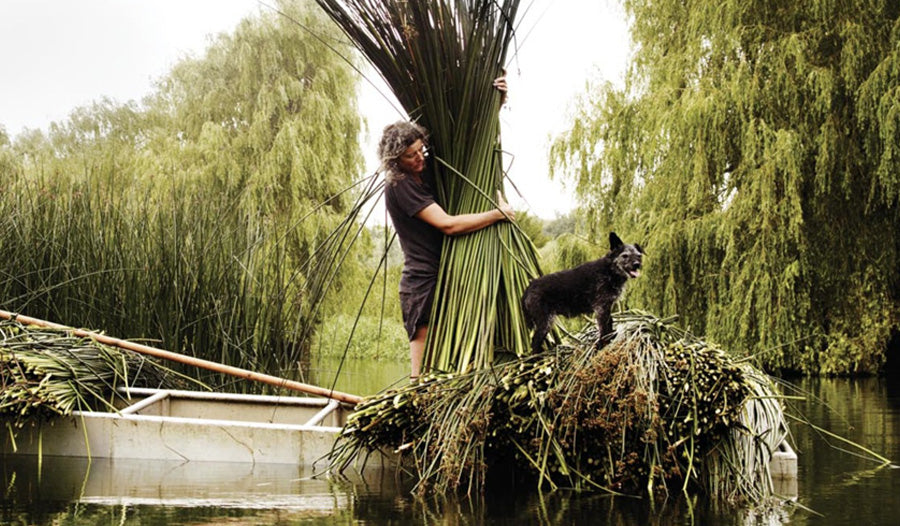
Rush Hour

An agricultural byproduct consisting of the dry stalks of cereal plants after the grain and chaff have been removed, straw is one of the most abundant ‘waste’ materials on the planet. During harvest season, it makes up about half of the yield of cereal crops such as barley, oats, rice and wheat and, as such, is extraordinary in the diversity of its practical applications.
We’re very excited for our upcoming online talk, Harvest, in which our speakers, all of whom still work closely with the materials that harvest provides, will discuss the many uses of straw in arts, crafts and adornment. It will take place next week, on Wednesday 15 September: Book tickets here.

Felicity Irons is a rush weaver, founder of Rushmatters, one of the last remaining rush weaving companies in Britain. Felicity started her practice in 1992, teaching herself the techniques and processes of rush weaving. Working from Grange Farm, Felicity Irons grows and harvests her own bulrushes from the Great Ouse river. The rush is harvested in the summer months, totalling over two tons a day and left to dry naturally before being plaited by Felicity and her team into bags, baskets and homewares. She will share with us her experience of harvesting and how understanding the harvesting of materials informs her weaving practice.
Helena Pozniak interviewed Irons for Selvedge Issue 46 Souvenir – read on for an excerpt of the article or read the full version here: Rush Hour: Felicity Irons was a Fast Learner.

When the last of a gargantuan length of rush matting was finally laid in the long gallery of Elizabethan mansion Hardwick Hall, rush worker Felicity Irons allowed herself a rare moment of pride. “When everyone had left, I drew breath and just stood there. This was the biggest piece I’d ever done. It took nine of us six months to make it. Fifty metres long, nearly seven metres wide, all handmade and fully fitted. I never thought we’d manage it.”
Lean, striking and immensely strong, 45-yearold Felicity sustains an industry that has all but disappeared from the east of England in the last 20 years. Her work – from delicate weaves to chunky coils of intense green bulrush – graces the tables, floors and seats of those with a taste for traditional crafts. Her chaotic workshop on a Bedfordshire farm is strewn with designs and projects, loose rush and half-finished matting as she strives to finish another sizeable order of some 30 chairs for an unnamed American client. “Oprah Winfrey?” she speculates, half joking.

What makes Felicity’s work so rare is her end-to end approach – she hand cuts and dries all her own rush every summer before heading back to her workshop for the rest of the year to plait, weave and sew her creations. Her craft is local because the gravel beds of the rivers Ouse and Nene offer some of the best rushes in the country. And it’s here on the edge of the fens in Cambridgeshire, Bedfordshire and Northamptonshire that she slices them with a six-foot scythe, before piling them high on a wobbly punt – this year she and her small team harvested 2,500 “bolts” or bundles of rushes, all now stored in a 12th century barn next door to her studio.
East Anglian summers are usually dry and hot – suited to drying rush in stubble fields and atop hedges without risk of mould. If the sun doesn’t bleach them too strongly, they retain a vivid green that can make the ubiquitous continental rush and water hyacinth look flat and grey by comparison. If it rains, Felicity bundles her crop into a greenhouse before all is lost…
Excerpt from the article Rush Hour written by Helena Pozniak that featured in Issue 46 Souvenir.
Harvest, our online talk featuring Hilary Burns, Felicity Irons, Nathalie Seiller Dejean, Veronica Main and Karolina Merska takes place next week on Wednesday 15 September. Find out more, and book tickets here: Harvest online talk.

1 comment
I would have liked to see some of her work,pieces!